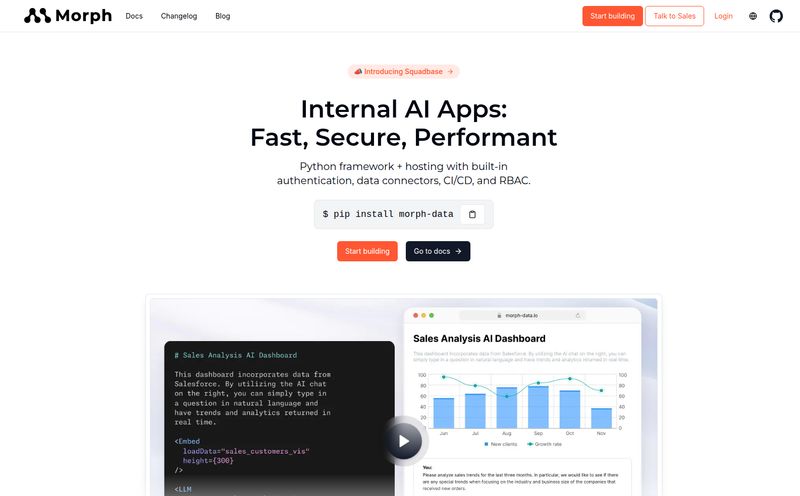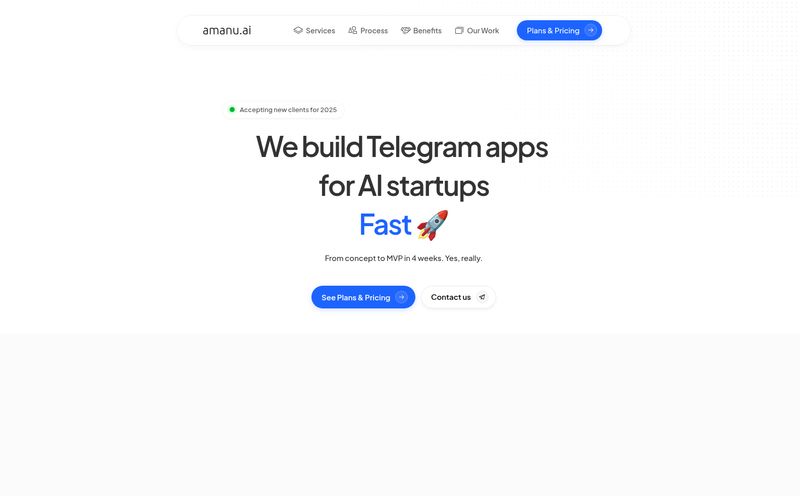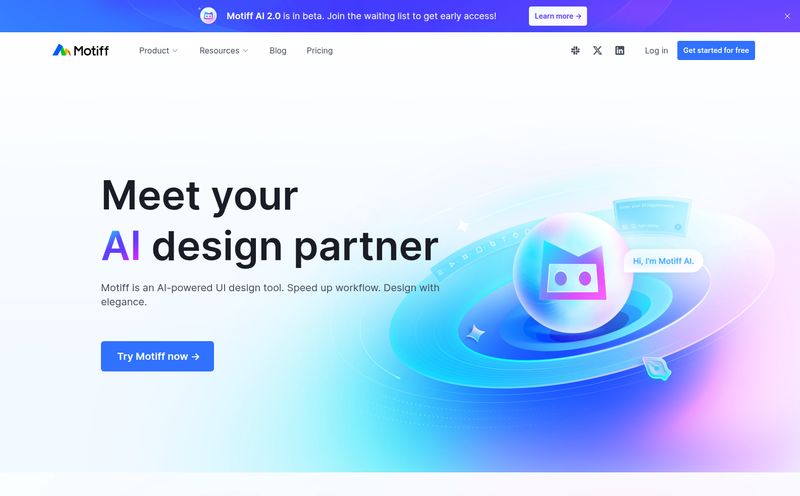If you've spent any time building with AI in the last couple of years, you know the feeling. You have a browser tab open for OpenAI's API keys, another for Anthropic, maybe one for Cohere, and you're trying to remember which project is using that open-source model you spun up on a server last month. It’s a special kind of chaos. It's a wallet-draining, time-sucking mess of credentials, pricing models, and documentation.
Every so often, a tool comes along that promises to be the 'one ring to rule them all'. A universal remote for the increasingly complicated television of AI services. I'm naturally skeptical. I've been in the SEO and tech game long enough to see a lot of promises fall flat. So when I heard about Taam Cloud, a platform claiming to unify all this craziness behind a single API key, my curiosity was definitely piqued.
Is this just another layer of abstraction we don't need, or is it the elegant solution developers have been quietly hoping for? I decided to take a closer look.
So, What Exactly is Taam Cloud?
First off, Taam Cloud isn't another LLM. It's not here to compete with GPT-4 or Claude 3. Thank goodness. Instead, think of it as the master plumber for your AI infrastructure. It’s the connective tissue, the central nervous system that lets you plug into over 200 different AI models without wanting to tear your hair out.

Visit Taam Cloud
The core idea is brilliantly simple: you get one secure AI API key from Taam Cloud. That's it. Just one. With that key, you can call on a massive library of models—from the big commercial players to niche open-source options. You don’t have to manage a dozen different accounts, billing cycles, or security protocols. It’s all piped through one clean, manageable endpoint. This is one of those 'why didn't I think of that' ideas.
The Features That Actually Matter
A shiny promise is one thing, but the devil's in the details. I’ve seen enough platforms with a great landing page and a hollow core. Here’s what stood out to me in Taam Cloud's feature set.
The Unified AI API: Your Golden Ticket
This is the main event. Access to more than 200 models is a huge deal. It turns model selection from a long-term commitment into an on-the-fly decision. Need a model that’s great at creative writing? Call one. Need a different one that’s cheaper and faster for simple classification? Call another. All using the same API structure. This dramatically lowers the barrier to experimentation. You can A/B test models in your app with a simple parameter change instead of a full re-integration. For developers, this is freedom.
The AI Gateway and Smart Routing
Okay, this part is pretty cool. The AI Gateway isn't just a dumb pipe. It can be configured for intelligent routing. Imagine you have a user query. The Gateway can automatically send it to the most cost-effective model that can handle the task. Or maybe it routes to the fastest model during peak traffic. This is where you move from just using AI to optimizing it. It’s a cost-control mechanism that works in the background, which is something your CFO will absolutely love.
Finally, Some Decent API Observability
If you've ever gotten a surprise bill from a cloud provider, you know the pain of poor observability. Taam Cloud seems to get this. The platform provides detailed logs, traces, and performance metrics for all your API calls. Finally. You can see which models are being used, how much they're costing, what the latency is, and where errors are happening. This isn't just a nice-to-have; it's a must-have for any serious application. Flying blind with API costs is a recipe for disaster, and this feature is the antidote.
The AI Playground and Built-in Agents
This is where the fun begins. The platform includes an AI Playground, which is basically a sandbox. You can test prompts across different models side-by-side without writing a single line of code. It's perfect for finding the right voice or capability for your project before you commit to building. Even better, it has built-in support for frameworks like LangChain and Autogen. This means you can go from testing a model to building a complex, multi-step AI agent or chatbot much, much faster. It's clear this was designed by people who actually build things with AI.
My Honest Take: The Good and The… Less Good
No tool is perfect, right? Here’s my no-fluff breakdown.
What I Love About Taam Cloud
The simplicity of the single API key can't be overstated. It's a genuine game-changer for workflow efficiency. The model variety is fantastic and encourages a 'best tool for the job' mentality. But for me, the combination of the AI Gateway for cost optimization and the API Observability for monitoring is the killer app. It addresses two of the biggest operational headaches in AI development. The enterprise-grade security is also a huge plus, making it a viable option for businesses that can't afford to play fast and loose with data.
Where It Could Improve
Alright, let's talk about the elephant in the room. The pricing. Like many enterprise-focused platforms, Taam Cloud uses a "contact us for pricing" model for its higher tiers. As someone who likes to see the numbers upfront, this is a bit of a pet peeve. It creates a friction point where there doesn't need to be one. I get it, enterprise deals are complex, but a little more transparency would be nice.
Also, it's a newer platform. That's not necessarily a bad thing—it means they're modern and probably not bogged down by legacy code. But it also means the community support around it, the Stack Overflow threads, the third-party tutorials, might still be growing. You’re betting on the team and their vision, which feels strong, but it's a different proposition from a tool that's been around for a decade.
Let's Talk Money: Taam Cloud Pricing
So, about that pricing. While we don't have exact dollar amounts, the structure is laid out. I've pulled the info from their site to give you a clearer picture.
| Plan Tier | Description | Best For |
|---|---|---|
| Basic | Get started with fast inference, reliability, and no daily rate limits. | Individuals and early-stage projects. |
| Build | Essential for regular users and enthusiasts. | Developers and small teams building active applications. |
| On-Premise | Run AI APIs within your own infrastructure for full control and compliance. | Large enterprises with strict security or data residency requirements. |
For specifics, you'll have to head over to their pricing page and likely get in touch with them. My guess is the Basic and Build tiers will have some form of pay-as-you-go pricing on top of the model costs, but that's just speculation.
Who is This Platform Really For?
After digging in, I have a pretty clear idea of the ideal Taam Cloud user.
- Startups and Agile Teams: If you're moving fast and need to prototype AI features without getting bogged down in infrastructure, this is for you.
- Scale-Ups: If your AI usage is growing and you're starting to feel the pain of managing multiple models and unpredictable costs, the gateway and observability features are a lifesaver.
- Large Enterprises: The on-premise option and the focus on security and compliance make it a serious contender for big companies that need a controlled, auditable AI integration layer.
Who is it not for? Probably the casual hobbyist who just wants to tinker with one specific free API. The value here really shines when you start juggling multiple models and need a robust system to manage them.
Frequently Asked Questions
- How is Taam Cloud different from just using OpenAI's API?
- OpenAI's API gives you access to OpenAI's models. Taam Cloud gives you access to OpenAI's models plus hundreds of others from different providers, all through one API. It also adds a layer of management, routing, and observability on top.
- Can I test models before committing to a plan?
- Yes, that's what the AI Playground is for. It's a sandbox environment designed for you to experiment with different models and prompts without needing to integrate them into your code first.
- Is Taam Cloud secure for enterprise use?
- It's built with enterprise-grade security and compliance in mind. For companies with very strict data policies, the On-Premise deployment option offers maximum control by keeping everything within your own infrastructure.
- What kind of models can I access through Taam Cloud?
- The platform provides access to over 200 models, covering a wide range of tasks including language generation, image analysis, and more. This includes popular commercial models as well as open-source alternatives.
- What is an AI Gateway?
- An AI Gateway acts as a smart traffic controller for your AI requests. It can route queries to different AI models based on rules you set, like cost, speed, or capabilities, helping you optimize performance and expenses automatically.
Conclusion: Is Taam Cloud the Future of AI Integration?
The AI world is still the Wild West. It's exciting, chaotic, and a little bit lawless. Tools like Taam Cloud are the sheriffs trying to bring some order to town. By tackling the very real, very tedious problem of API fragmentation and management, it provides a ton of value. It's not just about convenience; it's about enabling better, faster, and more cost-effective AI development.
While I wish the pricing was more transparent, the core product offering is incredibly strong. It solves a problem that almost every developer in the AI space is facing or will face soon. If you're building with AI and feel like you're spending more time managing keys and costs than actually creating, you should probably give Taam Cloud a serious look. It might just be the clean, unified dashboard your chaotic workflow has been crying out for.



